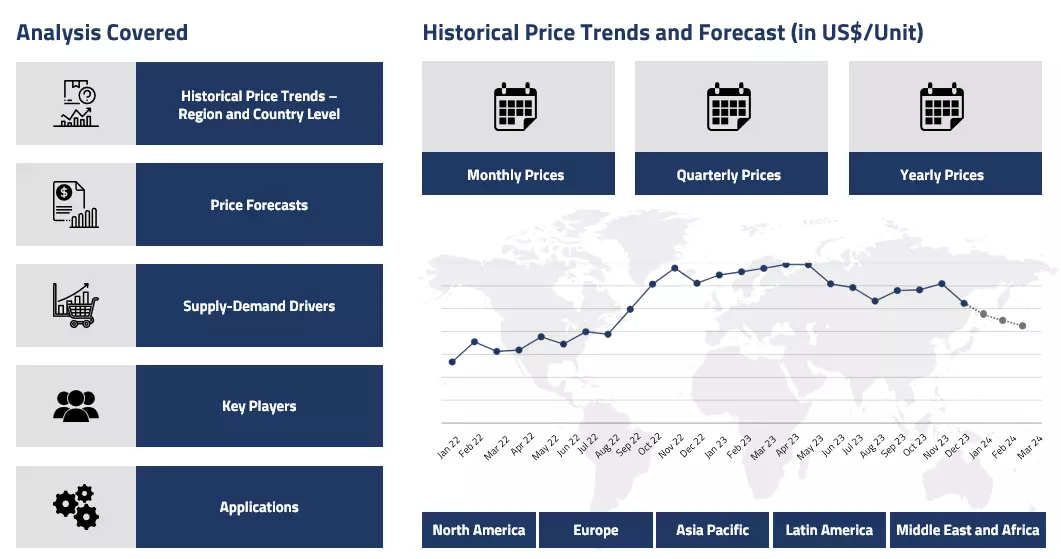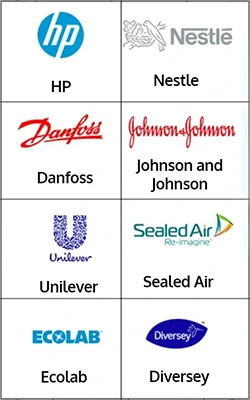Product
Thiourea Price Trend and Forecast
Thiourea Price Trend and Forecast
Thiourea Regional Price Overview
Get the latest insights on price movement and trend analysis of Thiourea in different regions across the world (Asia, Europe, North America, Latin America, and the Middle East & Africa).
Thiourea Price Trend for Q2 of 2025
Asia
In Q2’25, the Thiourea market in Asia saw a mixed but overall firm trend, shaped by seasonal agricultural demand and persistent logistical constraints. The quarter began with strong fertilizer consumption, especially in Southeast Asia during the rice and maize planting season. Demand remained healthy as countries like Indonesia and Vietnam increased application rates, while regional buyers restocked supplies.
Thiourea Price Chart

Please Login or Subscribe to Access the Thiourea Price Chart Data
However, pricing fluctuations were influenced by port congestion and shipping delays, particularly in China, where major ports struggled with increased cargo volumes and adverse weather. Though local production stayed stable, cautious purchasing and inventory buildup led to moderate price movements. Export activity from China stayed active but constrained due to long-term contracts and limited available shipping windows.
Europe
Thiourea prices in Europe initially remained under pressure during April and May due to soft agricultural demand and steady availability. However, market sentiment shifted in June as geopolitical tensions intensified, impacting regional supply chains. Transportation challenges due to low water levels on key trade routes and maintenance shutdowns at manufacturing sites created tightness in supply.
Further, the broader European fertilizer market experienced upward price pressure due to heightened freight risks and disrupted trade flows from major exporting regions. As a result, Thiourea prices edged higher toward the end of the quarter, driven by rising concerns over future availability and increased procurement activity.
North America
In North America, Thiourea prices moved upward through Q2’25, supported by a combination of supply constraints and weather-related disruptions. Facility outages and storm-related delays affected the domestic movement of agricultural inputs. Meanwhile, increased local demand during the spring planting season added to the pressure. Geopolitical uncertainty and new import tariffs led to reduced imports and a greater reliance on domestic supply, which was already under strain. These factors combined to push prices higher throughout the quarter, with buyers securing volumes early to avoid further market volatility.
Analyst Insight
According to Procurement Resource, Thiourea prices are expected to remain sensitive to global supply chain disruptions and seasonal agricultural demand, particularly in Asia and North America.
Thiourea Price Trend for Q1 of 2025
Asia
Throughout Q1’25, the Asian thiourea market experienced significant downward pressure as regional production capacities exceeded demand requirements. Chinese manufacturers, who dominate global production, operated at higher utilization rates following the Lunar New Year period, creating an oversupplied market condition. Downstream industries, particularly electroplating and metal finishing sectors, showed reluctance in procurement amid economic uncertainties in key markets like China and India.
The reduced logistics costs, following the easing of port congestion in major Chinese export hubs, further contributed to the softening prices. Japanese and South Korean buyers took advantage of this situation by adopting a cautious purchasing approach, primarily focusing on securing smaller volumes at favorable terms rather than committing to long-term contracts.
Europe
The European thiourea market displayed a relatively stable to soft trend during Q1’25. Prices initially held firm in January but gradually declined through February and March as imported material from Asia, particularly China, became more accessible and price-competitive. European manufacturers faced margin pressures due to high energy costs despite some moderation in natural gas prices compared to previous quarters. Demand from the agricultural sector remained seasonally low, while industrial applications showed limited growth.
The textile and rubber industries, significant consumers of thiourea in Europe, maintained minimal inventory levels and purchased primarily on a need-basis, reflecting overall market caution. Western European consumers benefited from this buyer-friendly market, leveraging the availability of multiple supply sources to negotiate more favorable terms.
North America
North American thiourea prices followed a similar downward trajectory during Q1’25, albeit with less volatility than observed in other regions. The market was characterized by sufficient supply availability, both from domestic production and imports. U.S. manufacturers maintained stable production levels despite facing competition from lower-priced Asian imports.
The mining sector, a key application area for thiourea in North America, showed modest demand as gold extraction activities continued at a steady pace. However, agricultural applications experienced seasonal lows typical of the winter period. The gradual easing of import tariffs on certain chemical intermediates also contributed to the softening price trend by allowing more competitive international material to enter the market.
Analyst Insight
According to Procurement Resource, Thiourea prices are expected to stabilize with a potential for moderate recovery in Q2’25, driven by anticipated seasonal demand increases from agricultural applications and possible production adjustments by major manufacturers to address current oversupply conditions.
Thiourea Price Trend for the Second Half of 2024
Asia
Asian Thiourea markets showed significant volatility in H2’24. In Q3, prices initially declined due to sluggish demand from the construction sector, but later increased when Typhoon Yagi disrupted chemical production in China. By Q4, the market experienced dramatic price swings with multiple rises and falls throughout the quarter. Mid-quarter, suppliers faced abundant inventories amid weak demand from cement and construction sectors. As 2024 closed, rising production costs combined with restocking urgency ahead of the Lunar New Year drove prices upward again, with suppliers raising prices to capitalize on improved market sentiment.
Europe
The European Thiourea market predominantly experienced bearish conditions during H2’24. The construction sector downturn significantly reduced product offtakes both within Europe and from importing markets. Supply remained abundant despite logistical challenges, including partial functionality of ports undergoing maintenance. By Q4, producers attempted to counter bearish sentiment by reducing operating rates, but these efforts had limited impact as industrial activities wound down for year-end holidays. With arbitrage opportunities closed, suppliers continued moving large volumes at competitive prices, further cementing the bearish trend throughout the second half of 2024.
North America
In North America, Thiourea prices experienced fluctuating trends during H2’24. The market initially witnessed price increases in early Q3, driven by logistics disruptions and delayed imports from Europe. The hurricane season, which extended through mid-November, significantly hampered transportation networks across the US. By Q4, destocking activities increased domestic supplies, pushing prices downward.
Manufacturing activities remained sluggish throughout the second half of 2024, particularly in the construction sector, which saw reduced spending due to rising mortgage rates. This consistent decline in demand, coupled with ample warehouse supplies, maintained downward pressure on Thiourea prices through the end of the year.
Analyst Insight
According to Procurement Resource, Thiourea markets globally are expected to stabilize in early 2025 as manufacturing activities resume, while persistent construction sector weakness may continue to limit demand growth.
Thiourea Price Trend for the First Half of 2024
Asia
In Asia, the thiourea market experienced continuous oscillations, particularly towards the lower end of the pricing spectrum, much like the urea market in the first half of the year 2024. The stability in urea prices due to consistent domestic supply and government subsidies in countries like India contributed to a similar trend in thiourea prices.
Despite some local challenges, such as reduced urea consumption in India due to the rise in other alternatives in the markets and weak demand in China, the overall market for thiourea remained steady. Additionally, the subdued buying interest and lack of significant international inquiries maintained a low-price trajectory for thiourea, in line with the static nature of urea prices.
Europe
In Europe, the thiourea market reflected the mixed performance of its feedstock urea sector. While European urea prices faced stagnation due to fluctuating demand and adverse weather conditions impacting agricultural activities, thiourea prices also showed stability. The availability of carried-over stocks of urea and increased domestic production provided a buffer against price volatility. The stability in urea prices, supported by sufficient stocks and steady supply chain operations, influenced a similar trend in thiourea prices, preventing significant price swings despite regional disruptions and geopolitical conflicts.
North America
In North America, thiourea prices aligned with the stable to slightly increasing cost of production, which in turn was based on positive prevailing sentiments of the urea market. The urea market's stability, with modest price changes and ample supply, translated into a similar pattern for thiourea. Further, the resilience of the fertilizer market, despite seasonal variations and logistical disruptions, supported thiourea prices, maintaining a consistent market environment.
Analyst Insight
According to Procurement Resource, the price of Thiourea is expected to sustain its upside momentum in the future quarters as well as the prevailing market dynamics suggest an optimistic trend.
Thiourea Price Trend for First Half of 2023
Asia
In the first quarter of 2023, the prices of thiourea inclined initially and then declined. The growth of the thiourea prices was supported by the rise in the cost of raw materials and demand from the downstream industries.
However, as the quarter progressed, the excess of supply and weak momentum of the Chinese market due to the poor trading sentiments of the region proved to be a struggle for the thiourea prices. The prices declined consistently in the second quarter, too, along with the persisting challenges; the cost of coal and feedstock also fell significantly, pushing the price trend of thiourea in the negative zone.
Europe
In European countries, the fertilizers sector and feedstock materials of thiourea witnessed a steep slump due to uncertainties in the cost of coal and natural gas. This led to the depletion of the costs of production, negatively affecting the price trend of thiourea.
The downfall of the fertilizers and other downstream industries led to a rise in the level of inventories, which was also affected by the poor purchasing potential of consumers in the first and second quarters of 2023. Further, the ongoing Russia-Ukraine crises caused the inflation rates to rise significantly, hurting the overall sentiments of thiourea prices.
North America
The cost of raw materials in the region suffered from the poor growth of the economy, hampering the prices of thiourea. In the first quarter, the natural gas prices fell to alarming levels while the rates of production increased by several folds. This imbalance caused the problem of excess influx of the product in the region.
These challenges persisted in the second quarter, too, which were accelerated by the extreme temperature conditions adversely affecting the export rates through water channels. In addition to this, the economic crisis caused by the failure of two major banks also added to the existing challenging conditions.
Analyst Insight
According to Procurement Resource, the price trend of Thiourea is estimated to follow an oscillating path as the market sentiments of the downstream fertilizers sector seem to be improving.
Procurement Resource provides latest prices of Thiourea. Each price database is tied to a user-friendly graphing tool dating back to 2014, which provides a range of functionalities: configuration of price series over user defined time period; comparison of product movements across countries; customisation of price currencies and unit; extraction of price data as excel files to be used offline.
About Thiourea
Thiourea has a faint odor and naturally occurs as a white crystalline solid. The compound has high solubility in water and a number of organic solvents. It also has the ability to aid in complex formation in various industrial processes. Due to its reducing nature, it can be used in textiles, metal cleaning, and photography; however, handling it should be done carefully.
Thiourea Product Details
| Report Features | Details |
| Product Name | Thiourea |
| Industrial Uses | Fertilizers, Metal cleaning and electroplating, Textile industry, Semiconductor industry |
| Chemical Formula | CH4N2S |
| Synonyms | Thiocarbamide |
| Molecular Weight | 76.12 g/mol |
| Supplier Database | Hebei Xinji Chemical Group Co Ltd, Guizhou Hongkai Chemial Co Ltd, Hongye Chemical Co Ltd, Shandong Tianfeng, Biotechnology Co Ltd, Acuro Organics Limited |
| Region/Countries Covered | Asia Pacific: China, India, Indonesia, Pakistan, Bangladesh, Japan, Philippines, Vietnam, Iran, Thailand, South Korea, Iraq, Saudi Arabia, Malaysia, Nepal, Taiwan, Sri Lanka, UAE, Israel, Hongkong, Singapore, Oman, Kuwait, Qatar, Australia, and New Zealand Europe: Germany, France, United Kingdom, Italy, Spain, Russia, Turkey, Netherlands, Poland, Sweden, Belgium, Austria, Ireland Switzerland, Norway, Denmark, Romania, Finland, Czech Republic, Portugal and Greece North America: United States and Canada Latin America: Brazil, Mexico, Argentina, Columbia, Chile, Ecuador, and Peru Africa: South Africa, Nigeria, Egypt, Algeria, Morocco |
| Currency | US$ (Data can also be provided in local currency) |
| Supplier Database Availability | Yes |
| Customization Scope | The report can be customized as per the requirements of the customer |
| Post-Sale Analyst Support | 360-degree analyst support after report delivery |
Note: Our supplier search experts can assist your procurement teams in compiling and validating a list of suppliers indicating they have products, services, and capabilities that meet your company's needs.
Thiourea Production Processes
- Production process by thermal decomposition of ammonium thiocyanate
Ammonium thiocyanate is first heated at around 432 K, which decomposes the salt and, after isomerization, produces thiourea.
Methodology
The displayed pricing data is derived through weighted average purchase price, including contract and spot transactions at the specified locations unless otherwise stated. The information provided comes from the compilation and processing of commercial data officially reported for each nation (i.e. government agencies, external trade bodies, and industry publications).
Assistance from Experts
Procurement Resource is a one-stop solution for businesses aiming at the best industry insights and market evaluation in the arena of procurement. Our team of market leaders covers all the facets of procurement strategies with its holistic industry reports, extensive production cost and pre-feasibility insights, and price trends dynamics impacting the cost trajectories of the plethora of products encompassing various industries. With the best analysis of the market trends and comprehensive consulting in light of the best strategic footstep, Procurement Resource got all that it takes.
Client's Satisfaction
Procurement Resource has made a mark for itself in terms of its rigorous assistance to its clientele. Our experienced panel of experts leave no stone unturned in ensuring the expertise at every step of our clients' strategic procurement journey. Our prompt assistance, prudential analysis, and pragmatic tactics considering the best procurement move for industries are all that sets us apart. We at Procurement Resource value our clients, which our clients vouch for.
Assured Quality
Expertise, judiciousness, and expedience are the crucial aspects of our modus operandi at Procurement Resource. Quality is non-negotiable, and we don't compromise on that. Our best-in-class solutions, elaborative consulting substantiated by exhaustive evaluation, and fool-proof reports have led us to come this far, making us the ‘numero uno' in the domain of procurement. Be it exclusive qualitative research or assiduous quantitative research methodologies, our high quality of work is what our clients swear by.
Table Of Contents
Our Clients

Get in Touch With Us

UNITED STATES
Phone:+1 307 363 1045

INDIA
Phone: +91 8850629517

UNITED KINGDOM
Phone: +44 7537 171117
Email: sales@procurementresource.com

